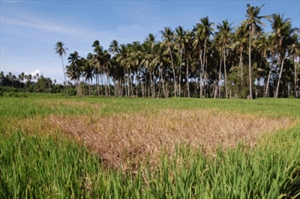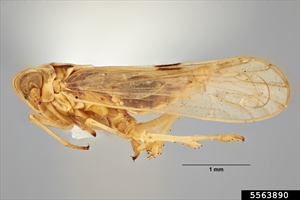White-backed planthopper
Pacific Pests, Pathogens and Weeds - Online edition
Pacific Pests, Pathogens & Weeds
Rice white-backed planthopper (423)
Sogatella furcifera
Asia, Africa (restricted), South America, the Caribbean, Europe (restricted), Oceania. It is reported from Australia, Federated States of Micronesia, Fiji, Guam, Marshall Islands, New Caledonia, Northern Mariana Islands, Palau, Papua New Guinea, Solomon Islands, and Vanuatu.
Rice is the main host, but maize and many grass weeds are also thought to be hosts.
An important pest of rice in rainfed and irrigated cultivation, with both nymphs and adults causing damage. The planthoppers prefer young plants, but all stages can be attacked.
Direct damage is done by sucking sap from the phloem, leading to stunting, fewer tillers, loss of grain weight and, in severe cases, 'hopperburn', as plants wilt, dry and eventually die (Photo 1). Indirect damage is caused by spreading Southern rice black-streaked dwarf virus; this virus occurs in Asia.
Eggs are laid into stems or along midribs of leaves. Nymphs pass through five stages over 12-18 days. Adults are about 2-3 mm long, pale brown, with a white stripe down the centre of the shield on the back that covers part of the head and thorax (Photos 2&3). Females either have short-wings or long; males are long-winged. Long-winged adults migrate when populations become large, food is insufficient and/or unsuitable. Large migrations occur in Asia in spring and summer, northwards from tropical and sub-tropical areas, over several hundreds of kilometres, e.g., from China to Japan and Korea.
The planthopper became a problem (like the brown planthopper - see Fact Sheet no. 64) with the introduction of short, high-yielding varieties that respond to high nitrogen applications. According to IRRI1, populations of 400-500 nymphs per plant or 200 adults, cause complete loss due to hopperburn. Outbreaks in South Asia and Southeast Asia have been reported. Outbreaks were caused by a combination of weather conditions - high early rainfall followed by long dry periods with high humidity - dense planting rates, and excessive use of nitrogen fertilizer and insecticides.
Look for a light-brown planthopper with a distinctive white line in the centre of the triangular shield that covers part of the head and thorax. Look for plants that have sooty moulds at the base of the plant, and others that have wilted, dried out and collapsed due to hopperburn.
NATURAL ENEMIES
The white-backed planthopper is usually controlled the mirid bug, Cyrtorhinus lividipennis (see Fact Sheet no. 419). However, the balance can be disturbed if broad-spectrum insecticides are used to control the planthopper or other pests.
CULTURAL CONTROL
Before planting:
- Aim to plant neighbouring farms within 3 weeks of each other, to avoid overlapping crops, and movement of planthoppers between fields.
During growth:
- Monitor with light bulb over pan of water away from nursery and outside of field.
- Apply nitrogen in split doses, being careful not to exceed local recommendations.
- Grow only two crops per year, and use early-maturing varieties.
- Drain fields for 3 or 4 days if heavy infestations occur.
After harvest:
- Do not ratoon the crop, i.e., do not allow it to regrow and continue growing after harvest.
- Plough the field after harvest, removing the stubble that would otherwise allow the planthoppers to continue to breed.
RESISTANT VARIETIES
Tolerant varieties exist, and they are part of an IPM program for this planthopper that includes cultural control measures and careful use of insecticides to preserve natural enemies, importantly the rice bug, Cyrtorhinus lividipennis.
CHEMICAL CONTROL
The recommendation of IRRI is to only use pesticides in the nursery (seedbed) if: (i) more than one planthopper per stem, or (ii) more planthoppers than natural enemies.
If using an insecticide, avoid the consecutive use of the same produce. If other insects are present, do not use broad-spectrum products, especially early in the season. Try to use those that are more specific for the pest that you are trying to manage. Consider the effect of insecticides on parasitoids and predators, especially early in the reason. Resurgence is a common problem after application of broad-spectrum insecticides as they destroy natural enemies.
____________________
When using a pesticide, always wear protective clothing and follow the instructions on the product label, such as dosage, timing of application, and pre-harvest interval. Recommendations will vary with the crop and system of cultivation. Expert advice on the most appropriate pesticide to use should always be sought from local agricultural authorities.
AUTHOR Grahame Jackson
Information from CABI (2018) Sogatella furcifera (white-backed planthopper). Crop Protection Compendium. (https://www.cabi.org/cpc/datasheet/50497); and information (and Photo 4) from Planthopper. Rice Knowledge Bank. IRRI. (http://www.knowledgebank.irri.org/training/fact-sheets/pest-management/insects/item/planthopper). Photo 1 IRRI Photos Part of the image collection of the International Rice Research Institute (IRRI). (https://www.flickr.com/photos/ricephotos/6233360329/in/photolist-66ExZW-8nPXie-66EDHS-66Ernj-66A8WM-66AfNR-xwT68F-xfpboh-xgtnnE-vuR2so-uynhx5-auPARP). Photos 2&3 Paul Langlois, Museum Collections: Cicadas, Planthoppers, & Allies, USDA APHIS PPQ, Bugwood.org.
Produced with support from the Australian Centre for International Agricultural Research under project HORT/2016/185: Responding to emerging pest and disease threats to horticulture in the Pacific islands, implemented by the University of Queensland and the Secretariat of the Pacific Community.






